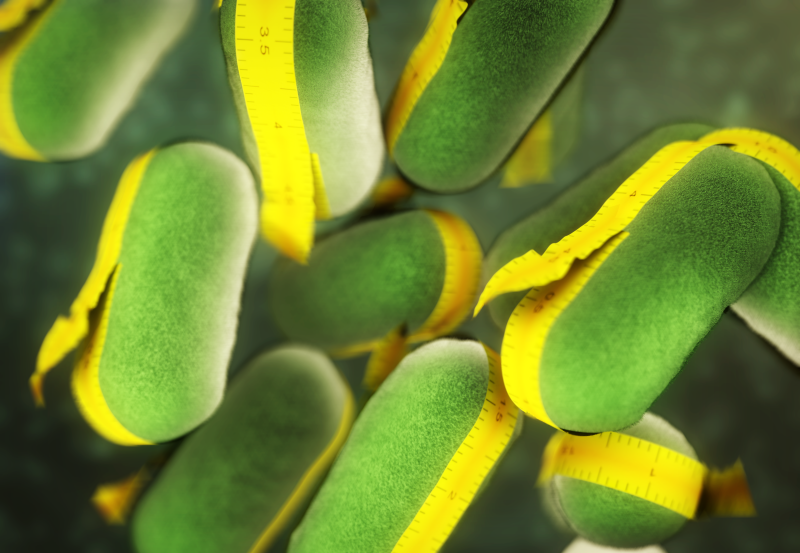How Bacteria Keep Track of their Size
How does a bacterium know when it has grown enough, and it’s time to divide? Various rules have been proposed, and now a report in Physical Review Letters offers a strategy where, in effect, a new-born cell adds a fixed volume to its initial size, regardless of what that size is. The model reconciles existing experimental data that appeared to conflict.
Most bacteria, such as the well-studied Escherichia coli and Bacillus subtilis, divide when they have approximately doubled their volume, but there is always a range of cell sizes. Some measurements suggest that cells can somehow “know” their absolute size and start replicating DNA in preparation for division when they reach some size threshold [1]. Many cell biologists accept this picture, but other findings apparently contradict it. For example, a “critical size” criterion should eliminate any correlation between the cell size at birth and at division, whereas such correlations do exist [2].
Ariel Amir of Harvard University now proposes a model for bacterial cell size regulation that reconciles these observations, and he begins by pointing out two extreme cases. In the first case, the volume at cell division ( ) is constant irrespective of small variations in the volume at birth ( ); in other words, there is a critical size for division, and the cell exerts “perfect” size control.
At the opposite extreme, is wholly dependent on —say, the cell divides when it has exactly doubled its initial volume. Since cell growth is exponential with a constant rate, a doubling in size implies a fixed growth time; the cell is “armed with a clock, not a ruler,” says Amir. Such a “timer” model would explain the observed correlations of with —but it would also lead to increasingly wide variations in cell sizes over time, as each generation builds on the randomness of the previous generation.
The apparently conflicting observations might be explained by a mechanism that lies between these extremes, Amir says, offering some limits over cell size without the cell having to measure its absolute size. After all, a bacterium does not care if it is 3 or 4 micrometers long, but it doesn’t want to be millimeter-sized.
Amir shows that a third, so-called “incremental” model, first broached in a different form in the 1970s, lies exactly halfway between the critical-size and the timer models. In this model, the cell doesn’t measure its absolute size, but it does measure its increase in volume from one generation to the next. In Amir’s version, a cell initiates DNA replication as soon as the total added volume—from the time when DNA replication began in its parent cell to the current time—reaches a specific amount. Amir says that a simple biochemical mechanism for achieving this, suggested in 1973, involves a protein that accumulates during growth and switches on replication when the number of copies of the protein reaches a threshold [3].
Throughout his analysis, Amir assumes that there is a range of cell sizes rather than working only with the average values. This approach turned out to be critical in reconciling the seemingly conflicting data, and he shows that his model is consistent with results that led others to assume a timer or “critical size” model. He shows that his model leads to a correlation between and that is not perfect (which would have implied a correlation coefficient of 1); in fact the coefficient is exactly 1/2, very close to the experimental value [2]. The model also predicts a coefficient of -1/2 (partially correlated but with negative slope) for the correlation between and the time before division, which is also close to the value very recently measured [4]. Finally, the model explains the observation, made nearly half a century ago [5], that the average cell size depends exponentially on the growth rate.
The greatest appeal of Amir’s work is that “it presents a simple phenomenological and analytically tractable model that explains a number of experimental observations in an elegant way,” according to biophysicist Cees Dekker of the Technical University of Delft in the Netherlands. Ned Wingreen of Princeton University finds Amir’s arguments persuasive. “It’s now in the hands of the experimentalists to determine the mechanism,” he says. Amir says that preliminary experiments suggest that the same mechanism operates in yeast as well as bacteria.
–Philip Ball
Philip Ball is a freelance science writer in London. His latest book is How Life Works (Picador, 2024).
References
- W. D. Donachie, “Relationship between Cell Size and Time of Initiation of DNA Replication,” Nature 219, 1077 (1968)
- L. J. Koppes, M. Meyer, H. B. Oonk, M. A. de Jong, and N. Nanninga, “Correlation between Size and Age at Different Events in the Cell Division Cycle of Escherichia Coli,” J. Bacteriol. 143, 1241 (1980)
- L. Sompayrac and O. Maaløe, “Indices of Discriminability,” Nature 241, 133 (1973)
- L. Robert, M. Hoffmann, S. Krell, Nathalie Aymerich, J. Robert, and M. Doumic, “Division in Escherichia Coli is Triggered by a Size-Sensing Rather Than a Timing Mechanism,” BMC Biology 12, 17 (2014)
- M. Schaechter, O. Maaløe, and N. Kjeldgaard, J. Gen. Microbiol. 19, 592 (1958)
More Information
For more on the history of the incremental model: W. L. Voorn and A. J. H. Koppes, Arch. Microbiol. 69, 43 (1998)





